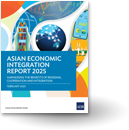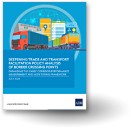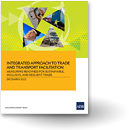Spotlight Archives
- ADB Seminar Series on Regional Economic Integration and Financial Sector Community of Practice Seminar: Financial Architecture for Effective SME Financing (26 August 2010, ADB Headquarters, Manila)20 August 2010Hyoung-Tae Kim, President of Korea Capital Market Institute, discussed the Korean experience in facilitating SME financing and lessons that can be learned by Asian policy makers in designing an efficient SME financing architecture. He argued that the vision and structure of SME financing has to be set according to the development stage of the institutions, markets and legal system of a specific country. Download the presentation.
- ADB Working Paper Series on Regional Economic Integration No. 56 - Production Networks and Trade Patterns in East Asia: Regionalization or Globalization?August 2010Prema-chandra Athukorala examines the implications of global production sharing for economic integration in East Asia, with emphasis on the behavior of trade flows in the wake of the 2008 global economic crisis. The findings yield the inference that rise of global production sharing has strengthened the case for a global, rather than regional, approach to trade and investment policy making. Read more.
- ADB Working Paper Series on Regional Economic Integration No. 55 - Trade Facilitation Measures Under Free Trade Agreements: Are They Discriminatory Against Non-Members?July 2010Are trade facilitation measures under free trade agreements (FTAs) discriminatory? This paper by Shintaro Hamanaka, Aiken Tafgar, and Dorothea Lazaro addresses this important question by citing both discriminatory and non-discriminatory examples of actual trade facilitation provisions in FTAs. Read more.
- ADB Identifies 233 FTAs in Asia and the PacificAugust 2010The spread of regional and bilateral free trade agreements (FTAs) in the Asia and Pacific region continues to gain momentum. From 54 FTAs in 2000, the Asian Development Bank (ADB) has identified 233 bilateral and plurilateral FTAs as of July 2010. Of these, 90 are in effect, 25 are signed, 63 are under negotiation, and 55 are in the proposal stage. Follow the FTA Trends.
- ADB Working Paper Series on Regional Economic Integration No. 54 - The Political Economy of Regional Cooperation in South Asia (July 2010)21 July 2010Independent consultant V.V. Desai discusses factors that led to the sub-par performance of the South Asian Association for Regional Cooperation. He concludes that building cordial interstate relations is a critical first step to improving its performance. Read more.
- July 2010 Asia Economic Monitor20 July 2010With emerging East Asia’s V-shaped recovery on track, it is now time to unwind the policy stimulus that helped power the solid domestic demand that kept growth strong, according to the July issue of the Asia Economic Monitor. The sustainability of the recovery will depend heavily on the timing, policy mix, and pace at which economic stimulus is withdrawn. Read the news release. Download the report.
- Seminar Series on Regional Economic Integration: The Regionalization of the World. What does it mean for Asia? (19 July 2010, 2:00 - 3:30 pm, Auditorium Zone A, ADB Headquarters)13 July 2010Prof. Luk Van Langenhove, Director, Comparative Regional Integration Studies Institute of the United Nations University, will discuss the relation between sovereign states and regional institutions in Europe’s experience, comparison with Asian regional integration and its global implications. Confirm participation with Liza Cruz. This seminar is organized in cooperation with the Asia-Europe Foundation (ASEF) as part of its 33rd Asia-Europe Lecture Tour in Singapore, Manila, Bangkok, Seoul and Shanghai.
- ADB Working Paper Series on Regional Economic Integration No. 53 - The Role of Membership Rules in Regional Organizations June 2010In this paper, Judith Kelley explores how membership rules affect the ability of organizations to promote regional integration. The paper studies the advantages and disadvantages of including versus excluding countries, and the benefits of having multiple regional organizations in a form of layered integration. Drawing especially on the European experience, the paper then discusses ways to vary membership of different cooperative efforts within an existing organization. The paper ends by considering the implications for Asia. Download the paper.
- Report: The Future Global Reserve System - An Asian Perspective (June 2010)24 June 2010A reform in the global reserve system is critical to avoid a repeat of the recent global economic crisis and Asia's fast recovering countries need to cooperate to ensure a smooth transition to a multi-currency alternative, says a new report from the Asian Development Bank and Columbia University's Earth Institute. The report, The Future Global Reserve System - An Asian Perspective, says that while the US dollar will remain the leading currency of international exchange for now, a rebalancing in the global economy means that in the future, a wider range of currencies will need to be used to settle trade and investment. Read the press release. Download the report or read it online.
- Seminar Series on Regional Economic Integration: The Doha Round, Regionalism, and Challenges to the International Trading System (25 June 2010, 7217/18 North, ERD Conference Room, ADB Headquarters, Manila)23 June 2010Robert Teh, Counsellor at the World Trade Organization (WTO), will discuss the role of the WTO in the current state of the Doha Round amid rising regionalism and the challenges it poses to the international trading system. He will present arguments why despite the difficulties encountered in concluding the round and the rise of regionalism, the WTO will remain indispensable for managing the many challenges that confront the international trading system. Confirm participation with Liza Cruz.




